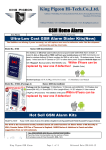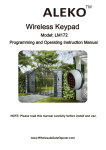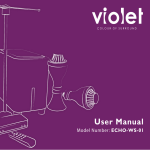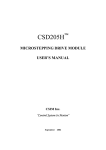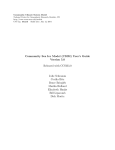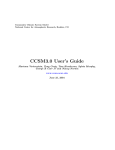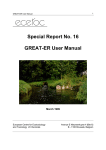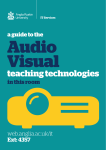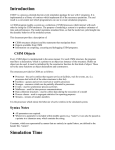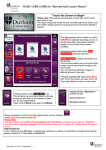Transcript
USER MANUAL For AC-TXM and AC-RCVR Linked ™ For instructions on programming a controller with the wireless system, see attached. • Address bar on the AC-TXM and AC-RCVR provides for 1,204 unique address possibilities. This allows for multiple zones and no interference between classrooms located in close proximity with each other. • Each module is powered by using a 24V power supply. • 418 MHZ AC-TXM sends 4 separate commands: on, off, up, down. This prevents the system from getting out of sync. Control Modules • The AC-TXM and AC-RCVR address bar dip switches must match. Use a pen or screwdriver to gently move switches. • AC-TXM power supply is 24V 1.67 A, 40W with power cord • Connects to major brand controller or NOVA’s Independent Switching Interface (ISI) with standard RJ45 CAT6 patch cables • Mounting bracket included for AC-TXM and AC-RCVR Address Bar Configuration for Wireless NOVALinked™ RF Transmitter, typically located on lectern (Qty 1) Has a unique frequency. AC-TXM Receiver 1 per row (Qty 4) AC-RCVR Independent Switching Interface, typically located on lectern (Qty 1) AC-ISI Linking Control Interface 1 per Trolley, except in Lectern when using a CSIM or Transmitter If Lectern utilizes a Trolley with CSIM or Transimitter, then no need for an LCI. (Qty 20) AC-LCI CAT6 Patch Cable 1ft or 2ft cable needed to run from RCVR to the 1st LCI in each row (Qty 4) AC-CAT6-2 5ft or 7ft cables needed to run from LCI to LCI in each row (Qty 16) AC-CAT6-5 This equipment has been tested and found to comply with the limits for a class B digital device, pursuant to part 15 of the FCC Rules. These limits are designed to provide reasonable protection against harmful interference in a residential installation. This equipment generates, uses and can radiate radio frequency energy and if not installed and used in accordance with the instructions, may cause harmful interference to radio communications. However, there is no guarantee that interference will not occur in a particular installation. If this equipment does cause harmful interference to radio or television reception, which can be determined by turning the equipment off and on, the user is encouraged to try to correct the interference by one or more of the following measures: * Reorient or relocate the receiving antenna. * Increase the separation between the equipment and receiver. * Connect the equipment into an outlet on a circuit different from that to which the receiver is connected. * Consult the dealer or an experienced radio/TV technician for help. Operation with non-approved equipment is likely to result in interference to radio and TV reception. The user is cautioned that changes and modifications made to the equipment without the approval of manufacturer could void the user’s authority to operate this equipment. © 2012, NOVA Solutions, Inc. NOVALinked_USER_MANUAL 11/12

